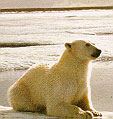
Focus on the Canadian Wildlife Service
Table of contents
For many of us, Canada's wildlife provides powerful images that help define the very essence of our country. As noted Canadian conservationist C.H. Clarke said, "were our land to lose its beaver, its caribou, its loons, its wolves... we would have lost our soul."
Although we share our land, water, and air with wildlife, at times it is an uneasy harmony. Changes in the environment, either from human activity or other sources, affect wildlife, and eventually affect us. By practising wildlife conservation we are protecting our own species.

The Canadian Wildlife Service (CWS), part of Environment Canada, handles wildlife matters that are the responsibility of the federal government. These include protection and management of migratory birds, nationally significant habitat and endangered species, as well as work on other wildlife issues of national and international importance. In addition, CWS does research in many fields of wildlife biology.
In 1997, the Canadian Wildlife Service (formerly Dominion Wildlife Service) celebrated its fiftieth year as a federal agency responsible for conserving canadian wildlife.
A short history
In the early 1900s there was a drastic decline in migratory bird populations, particularly in eastern North America. One victim, the Passenger Pigeon, which had thrived in the 1880s, became extinct after intense hunting. The last Passenger Pigeon died in captivity in 1914.
As the decline in abundance of migratory birds was a responsibility shared
by all states and provinces, an agreement between the Canadian and American
federal governments was required to regulate hunting and undertake conservation
programs. In 1916, Canada and the U.S. signed the Migratory Birds Convention,
and the following year Parliament passed the Migratory
Birds Convention Act giving the federal government responsibility
for the management of certain species of migratory birds. In 1947, the
Dominion Wildlife Service was created, to bring together public servants
with responsibilities for conservation of birds and terrestrial mammals.

By the late 1960s, it was clear that action by the federal government
was required on many other issues, such as management of mammals that
cross international boundaries and the serious problem of species becoming
threatened with extinction. As a result, in 1973 the Canada
Wildlife Act was passed enabling the federal government to carry
out wildlife research and, in cooperation with the provinces, to undertake
a wide range of wildlife conservation and interpretation activities
for "any non-domestic animals or their habitats."
Current activities
Conservation of migratory birds
CWS conducts research on a wide variety of wildlife topics, particularly migratory birds. Its research provides the science base for conservation actions.
To maintain optimum populations of migratory waterfowl, various field surveys are conducted in cooperation with the U.S. Fish and Wildlife Service and other organizations. Hunters are also asked to get involved by answering a questionnaire about the number of birds killed and by sending in duck wings and goose tails. By examining the wings and tails, biologists can determine the age and number of each kind of bird taken in a given year.
Since 1968, CWS has coordinated an annual national survey of breeding non-game birds, mainly songbirds. Each year, on early June mornings, volunteers record the breeding birds present along prescribed routes. Annual changes in numbers and long-term population trends are valuable indicators of environmental change.
When coastal habitats are ravaged by oil spills, the effects on seabirds can be devastating. Increased development and offshore activities in the Arctic, where many species breed, threaten the seabird populations. Information on their numbers and distribution in nesting areas and at sea is gathered, and maps are produced showing critical areas.
The most ambitious migratory birds conservation program to date is the North American Waterfowl Management Plan (NAWMP). It is a $1.5 billion joint Canada / U.S. program designed to protect and enhance wetland habitat throughout North America. Waterfowl are the most economically important group of migratory birds, but they face a serious decline throughout their range. The objective of NAWMP is to restore the populations of ducks, swans, and geese to the levels of the 1970s.
Conservation of other wildlife species

Caribou, such as those in the Porcupine and Beverly-Kaminuriak herds, cross provincial and territorial boundaries as well as international boundaries during their migration. CWS is part of an international management committee charged with ensuring the well-being of various caribou herds by providing research and conservation expertise.
Species at risk
The Canadian Wildlife Service (CWS) plays a prominent role in the protection of species at risk. CWS developed and promoted the adoption of the Species at Risk Act (SARA). This act, which came into effect in 2003, protects species from extinction and their critical habitat from disappearance, and it ensures their recovery. The CWS is also a founding member of the Committee on the Status of Endangered Wildlife in Canada (COSEWIC), which assesses the status of species at risk in Canada. The SARA List of Wildlife Species at Risk is based on COSEWIC designations. Moreover, CWS takes an active part in the national program called Recovery of Nationally Endangered Wildlife (RENEW), which brings together Canadian organizations and groups with an interest in the recovery of species whose status has been established. It takes part in recovery strategies for species including the Whooping Crane, the Peregrine Falcon, the Piping Plover, the wood bison and the swift fox. These strategies range from the captive breeding of animals and their release into the wild, to the close monitoring of human access to the natural habitat of targeted species and of human activities in the habitat in question.
International programs
In addition to cooperative programs with the United States, CWS is involved in numerous international activities. These include projects where there is a shared population to manage, as with Lesser Snow Geese, which spend the summer in Russia and the winter in Canada near Vancouver.
The Convention on International Trade in Endangered Species of Wild Faune and Flora (CITES) is an effort to protect endangered species by regulating trade in over 15,000 species of wild plants and animals and their parts or derivatives. Canada is a party to CITES, and CWS is responsible for implementing CITES in Canada.
Other examples of international activities are the Latin American Program (LAP) and the Western Hemisphere Shorebird Reserve Network (WHSRN), which focus on migratory birds common to both American continents. By strengthening relationships with the Latin American countries, CWS is able to share research and conservation expertise on migratory birds and their habitats.

Canada is one of five countries with populations of polar bears. CWS research helps to estimate their population and their ecological requirements by studying the bears' longevity, feeding, breeding, and denning habits. An international conservation agreement with the U.S.A., Russia, Norway, and Denmark provides for information exchange and for cooperative research on the great white bear.
The Convention on Wetlands of International Importance especially as Waterfowl Habitat, or the Ramsar Convention (after the city in Iran where it was drawn up), came into force in 1975 to designate and protect globally important wetlands. Canada joined the convention in 1981 and named Cap Tourmente National Wildlife Area in Quebec as the first Canadian wetland of international importance. Since then, 35 more sites have been designated, encompassing 13,000,000 hectares, one of the largest areas yet declared by any member.
Conservation of wildlife habitat
Habitat used by wildlife is also essential for agriculture, forestry, and other competing interests. To accommodate all concerns, CWS works with other agencies and groups to minimize the impact on critical wildlife habitat. CWS's most direct role is in the establishment and management of National Wildlife Areas and Migratory Bird Sanctuaries. There are more than 140 of these refuges across the country. Another major habitat protection program is the North American Waterfowl Management Plan.
Environmental impact studies are conducted by CWS to determine the effects of large-scale development projects on wildlife habitat. Many of these studies are in the north, a region which has just begun to feel the effects of resource development. Without proper planning, major developments could permanently damage the ecosystem.
CWS also provides advice on projects such as planning the location of highways and pipelines to avoid sensitive habitats. Along the St. Lawrence River valley, biologists are studying the impact of shoreline disturbance on bird populations. Other industrial activities, such as hydro developments in the James Bay region and a tidal power proposal in the Bay of Fundy, have shown the need for studies of vital shorebird feeding and resting areas.
The effects of pollutants on wildlife
The dangers of pesticides and acid rain have become all too familiar to Canadians. Not surprisingly, the threat is no less serious to wildlife. Chemical contamination of wildlife populations provides a useful indication of the overall health of the environment. Therefore, wildlife biologists monitor the effects of toxic chemicals entering ecosystems through such human activities as agriculture, industry, forestry, and urbanization.
CWS has demonstrated that the breeding success of fish-eating birds has been reduced as a result of toxic chemical contamination in the Great Lakes. By examining the feeding areas and habits of species such as the Herring Gull, researchers can determine where pollutants are building up and obtain an early indication of the problems in an ecosystem.
Pesticides are used extensively in modern agriculture and forestry. CWS conducts research on their impact on wildlife and provides advice to the Pest Management Regulatory Agency on their registration and use.
Current studies on the impact of long-range transport of airborne pollutants on wildlife are examining the effects of acid rain on waterfowl in eastern Canada and the resulting socioeconomic impact.
Partners in wildlife conservation
CWS is involved in a wide range of wildlife research, conservation, and public awareness activities. All Canadians have a stewardship responsibility for wildlife. We at CWS invite you — as an individual or as part of a group — to work with us to ensure that there will be abundant, healthy wildlife populations for the benefit of this and future generations.



